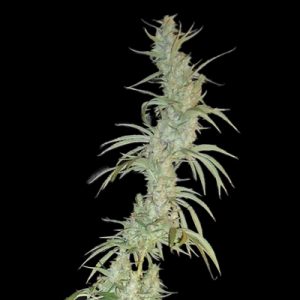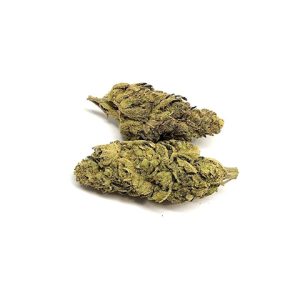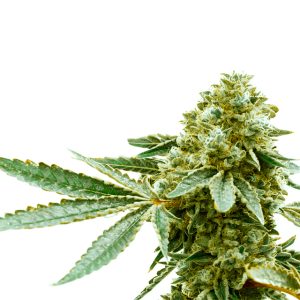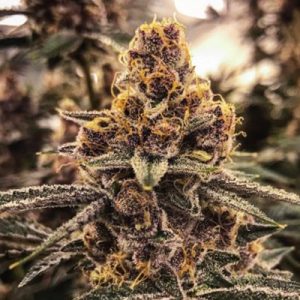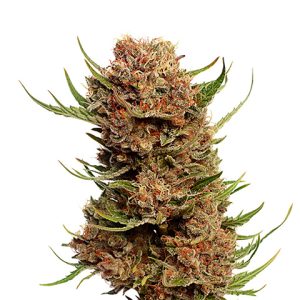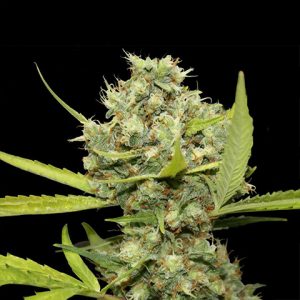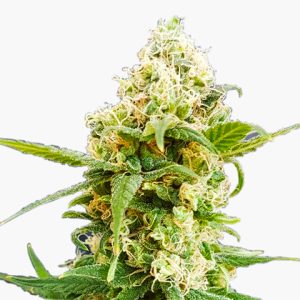Tropical Strains: Cannabis with Tropical Lineage
What Are Tropical Seeds?
Tropical seeds are a gang of cannabis plants descended from a combination of the Hazes and landraces from Southeastern Asia, Latin and South America, and Hawaii. Their sativa dominant plants grow tall ganja bushes that can grow up to a pound per plant when kept in sunny and warm environments outdoors. The indica members of this family grow thick, bushy, horizontally spreading plants that do very well in hydroponics tables. All members of this family have a fruity flavor or smell and hit their users with a rush of trippy euphoria early on. Their incredibly blissful highs are suitable for social engagements and creative activities, though some of the indica varieties have a tendency towards couch lock and time dilation. Tropical plants are potent weeds, with THC contents between seventeen and twenty-four percent. They are often high in the terpenes limonene and myrcene which give them their signature flavors and smells. Many of the members of this family also have Skunk genes, making them more citrus than other plants. Some of these plants are award winners, like Hawaiian Snow. Others are mainstays of the vape cartridge, concentrates, and edibles scenes with their crowd-pleasing flavors and high THC content. Kind Seed Co carries over two dozen Tropical and Tropical affiliated strains including Pineapple, Tropical Cookies, Hawaiian Snow, Hawaiian Skunk, Pineapple Skunk, Pineapple Haze, Chocolope Candy, Tangerine, Pineapple Chunk, Somango, Sweet Island, Green Somango, and family ancestors from the Haze Family including elders Neville’s Haze and Hawaiian Haze. You can read all about them and many more right here on Weed Seeds’ website!
Where Do Tropical Cannabis Seeds Come From?
Many Tropical genetics were engineered using a mix of Hazes and tropical landraces. Hawaiian Snow is descended from Hawaiian and Laotian sativa genetics according to some, but a mix of Neville’s Haze, Pure Haze, and Hawaiian Haze according to others. Many of the Hazes were first engineered in California before being brought to the Netherlands, possibly the Sam the Skunkman or maybe by the Haze Brothers themselves. In any case, many of these seeds were brought to various places around the world, consolidated like so many others thanks to the legal landscapes of the Netherlands, and proliferated from there to create lines of fruity buds that make users feel like they’re on a beach in the Caribbean. Hawaiian Snow is a sister strain to other fruity and humidity loving buds including Hawaiian Haze, Pineapple Banana Bud, Hawaiian, Baphomet, Goat Scout Cookies, Cherry Bomb, G13 Haze, Morning Glory, and Sweet Tooth. Hawaiian Snow has also made its own crosses, including Holy Snow, Cannabista, Ala Moana, and blends with Wedding Cake x Gelato 33, Sour Banana, Amnesia Haze x Face Off, and Amnesia x Do Si Dos. Hawaiian Skunk is from a mix of Purple Skunk and Hawaii. Ed Rosenthal’s Super Bud created a phenotype now known as the strain Pineapple. ERSB is a four way cross of original strains from around the world, mostly equatorial regions. Tropical Cookies is a mix of Tangie and GSC. Tropical Cookies has also birthed its own children in Tropic Truffle and Beach Wedding. For more information on these and six hundred other strains, check out our Weed Seeds’ catalog today!
Why Buy Tropical Seeds?
Tropical plants are generally easy to grow, and come in a range of styles to suit many growing needs. They’re also adaptable, able to grow all over America with the right treatment. They have a potent THC content between seventeen and twenty-four percent, and are suitable for a wide range of ailments. Many of the more indica dominant portions of the family are excellent for tackling chronic pain and insomnia, while the sativa dominant side of the family is notorious for vaporizing mental health issues. The majority of this family has a light and fruity bouquet, with notes of spice and green herbs throughout. With our vast website full of information on our over six hundred different types of seeds, Kind Seed Co prides ourselves on delivering exactly what you need. Whether you’re looking for autoflowering, photo period, unsexed regular, fast-flowering, high CBD, or low THC seeds, we want to be your online seed bank. It’s never been easier to learn all about your products and how to grow them before you order, and our excellent customer service team makes ordering your seeds a breeze. Simply put together your order using our online store, follow the checkout procedure, and wait five to fourteen business days for your seeds to arrive in subtle packaging. Weed Seeds wants to make sure you have all the information you need to grow a stellar crop before your seeds even arrive, which is why we provide detailed growing information available twenty-four hours a day right here. KSCO is number one for a reason!
Seed Storage Of Tropical Cannabis Seeds
Tropical seeds sprout in tropical conditions, warm and wet. It’s wise to keep your seeds away from any kind of moisture or excessive heat. If you’re only planning on storing your tropical seeds for six or eight weeks, leaving them in the package they were sent to you in and leaving that package in a dark and dry drawer where they won’t be crushed or accidentally have moisture spilled on them is relatively safe. However, more precautions should probably be taken if you’re planning to store your seeds for any longer. Don’t handle your seeds with bare hands, as bacteria and oils on human hands can impact the health of seeds in the long term. If you’re just about to put them in the ground and you’ve just washed your hands, you’re probably safe. However, if you are planning on storing the seeds with others, or for an extended period of time, always use a clean glove or tweezers. While cannabis seeds don’t need to be stratified, or given a period of cold temperatures in order to show them when to germinate, they will keep well at low temperatures so long as the humidity is low. It can be risky to put seeds in fridges due to inconsistent temperatures and humidity that can cause seeds to freeze or rot. The most optimal place to keep seeds for up to six months is in a root cellar with a relative humidity of between eight and ten percent. Weed Seeds loves helping you grow your greatest crop ever, even six months from now.
Germinating Tropical Seeds
The trick to getting Tropical seeds to germinate is to use the most reliable low-tech method and to not bother them too much until they’re ready to go. To begin, it’s wise to soak your seeds in a cup of distilled water overnight. The next morning, drain a lot of the water out and put the seeds and some of the water onto a paper towel that has been put on a clean dinner plate. Get the paper towel wet enough with distilled water that it’s all wet, but not so much that it leaves puddles on the plate when you lift up the towel. Once the paper towels are at the right moisture, make sure all your seeds have at least an inch radius of space so they won’t grow into one another. Place another wet paper towel on top of your seeds, and then a plate face to face with the other one, to create a somewhat closed off dome that can retain moisture but still allow air to flow through to some extent. Leave this arrangement of plates in a warm and dark spot in the house where the temperature doesn’t fluctuate a lot. Watch the seeds and the paper towels carefully over the next week. The seeds should sprout within a day, and will be ready to transplant within a week. All seeds bought from KSCO have a high germination rate that’s sure to bring you satisfaction with your grow.
Growing Tropical Cannabis Plants
Tropical plants like temperatures between seventy-four and eight-two degrees Fahrenheit depending on their strain and the growing phase they’re in. Some of this family can get quite large due to their sativa landrace genetics, while others like Hawaiian Skunk plants are much smaller due to their indica leaning genetics. Many of the smaller plants like to grow horizontally and benefit enormously from a little bit of pruning to improve the airflow to their innermost branches. Sativa-dominant tall plants can be encouraged to grow in a similar fashion with topping and FIMming. Topping chops the plant to the first node of the newest central growth, while FIMming only takes the leaf matter from the topmost leaves. Tropical plants like a soil pH of around six point two, with six point five also being acceptable. The autoflowering varieties among this family can do very well in any manner of environments. Autoflowering plants need fewer nutrient inputs than other plants, but they still like to get some extra nitrogen during vegetation, some added calcium and magnesium as they are flipped, and extra potassium and phosphorus during flowering. Tropical Cookies can be grown just about anywhere using any kind of growing medium, as can many of the Tropical family. However, it’s generally considered a best practice to use organic soil for cannabis in order to bring out its complex flavors. Hydroponics are preferred when the crop doesn’t have to be perfect but needs to be done quickly and in uniform fashion. For the most potent chronic plants you’ve ever had in your life, come to Weed Seeds!
Growing Flowers From Tropical Seeds Indoors
Tropical plants benefit enormously from a few simple low stress training techniques including the Screen of Green, or ScrOG, and the Sea of Green. These techniques are used when there is not a lot of vertical space for the plants to grow in, or when growers want to maximize their yields from each plant by exposing more of it to direct light. The Screen of Green uses mesh to suppress large leaves of plants, while bud sites are woven through so they can take advantage of the abundant direct light above. The Sea of Green is a technique that packs many small plants into a small space and causes them to grow wrapped around one another for support. These tiny plants are then flipped to flower early, creating one huge bud cola on each tiny plant. Purple Hawaii Skunk needs a little bit of extra care, but does very well in a Sea of Green technique. Hawaiian Snow has a tendency to get quite tall outdoors, but can be used quite successfully indoors using a ScrOG. Tropical Cookies is another strain that does well indoors, where it can double its yield when grown with low stress techniques. When grown using hydroponics, most Tropical strain plants like a pH of around five point eight. Tropical plants like temperatures around seventy-five degrees Fahrenheit indoors. Humidity can be in the mid-fifties during vegetation but should be dropped down to the high thirties during flowering. Whether you’re populating a warehouse or a closet, KSCO has all the information you need to make the most of your growing space!
Growing Cannabis Flower Outdoors From Tropical Seed
Many Tropical family plants are adaptable when it comes to the environment they are growing in so long as they are supplied with temperatures in the mid to high seventies. That being said, just because these are Tropical plants doesn’t mean they love humidity. Most Tropical family strains will thrive in a Mediterranean climate like Southern California. However, even a summer in New England can produce some beautiful results provided you’ve kept the airflow around your plants high and protected them from pests and rain. Hawaiian Snow and its relatives can get quite large when it’s outdoors and in soil that it can make a large taproot in. If you live somewhere with quite a long growing season, and have a spot that gets plenty of sun and air flow, you’ve got your work cut out for you! Tropical Cookies like to be inside by the end of October in places with this kind of atmosphere. Autoflowering Tropical Cookies might not get to its optimal yields when growing outdoors, but the exposure to cooler nighttime temperatures during the later stages of its flowering can help it produce beautiful purple buds thanks to its GSC genetics. Its autoflowering genes also mean that you can let the sun do its work without having to meddle with complicated lighting switches. Greenhouses are a great choice for photoperiod plants that want a totally lightless twelve hours during their flowering phase. This has the added benefit of protecting plants from rain. When you want sneaky growing hacks and fabulous genetics, you come to WS!
Typical Aroma Of Tropical Cannabis Buds
Most Tropical strains are true to their names, and carry the smell of mangos, papayas, citrus fruits, coconuts, guavas, passionfruit, and other tropical crops high in things like myrcene and limonene. These are, in fact, the two most common terpenes in Tropical strain flowers. The scent profile of Purple Hawaii Skunk for example is a pungent, earthy pong with citrus notes. Hawaiian Snow has a sweet aroma and taste, with notes of citrus and tropical fruits in the mouth and pine in the nose. Limonene, linalool, and myrcene are the main terpenes in Hawaiian Snow, with linalool and limonene giving it that fresh scent. The fragrance of Hawaiian Skunk is earthy, like ground coffee, but surprisingly full of notes of pine and sweet caramelized sugars. The Skunk parts of its bouquet are present after the joint is lit. Pungent citrus and dank notes permeate Hawaiian Skunk’s silage once it’s lit, with hints of pine jumping out. Tropical Cookies smells like orange peels and fresh soil, with a sugariness that hangs in the air long after the joint has been snuffed out. Many of these smells appear on the plants quite early in their flowering phases, shifting from pungent skunk to light pineapple as the buds grow and cure. This family has a tendency to smell that same sweet and skunky way when in the jar, with the earthy and spicy notes of some strains coming out most when buds are ground up. Whether you’re looking for tropical fruit flavors or skunky dankness, Weed Seeds carries over six hundred varieties to suit any discerning nose!
Harvesting Time When Growing Tropical Strains
The Tropical family generally have flowering times between seven and eleven weeks. Purple Hawaiian Skunk has a flowering time of seven to nine weeks. Hawaiian Skunk and Pineapple’s flowering period is between eight and ten weeks. Hawaiian Snow and Tropical Cookies seeds take nine to eleven weeks of flowering time to mature. Most Tropical plants do their most productive and delicious work when given ample time to both vegetate and flower. That isn’t to say that rapid flowering indoor hydroponic techniques won’t work, just that large plants generally grow more buds than small plants, and large plants take quite some time to grow. Flowering time is an estimate of how long it will take a crop to go from budding to maturity, and when exactly to harvest is more a matter of the plant’s readiness than a strictly held number of days. To make the wisest harvest call for your weed, it’s advisable to use a magnifying glass to watch the trichomes of your plants. Trichomes will begin their lives clear, but become white and opaque as they fill with THCA, the acid that turns into THC. If the plant is left to grow past its peak THC production moment, the THC will begin to turn into CBN. CBN, short for cannabinol, creates a much mellower and more sedative high than THC. To harvest your plants at their most potent, cut them when three-quarters of the trichomes are white. When you buy your seeds from KSCO, we’re committed to helping you grow the crop of your dreams every time.
What Yield Can You Get From Tropical Plants
The yield of Tropical strains is quite good, and they do well indoors where they benefit from precise environmental conditions, low stress training, and consistent and intense light. Hawaiian Snow plants can produce half a pound to four hundred grams per meter or three to five hundred grams per plant. Hawaiian Skunk and Purple Hawaii Skunk can grow a little more than a pound per square meter or per plant. Even the autoflowering versions of Pineapple and Tropical Cookies can produce up to a pound of bud per square meter of low stress treatment growing space when grown indoors, though they can only produce around half of that amount per plant outdoors. You can help to increase the yield of your plants by feeding them properly with plenty of nitrogen during their vegetative phase. It’s worthwhile to slow down your production if you’re growing just a few plants. Give them up to three months to vegetate, especially varieties that get tall like Hawaiian Snow. While intense production of many small plants can yield large crops quickly, there’s nothing quite like a crop of a similar size grown slowly in living organic soil for flavors and quality. Remember when harvesting Tropical buds that they can be quite sticky. If you are working with large amounts of resinous cannabis flowers, it’s wise to protect yourself and your tools from their resin by covering your skin and cleaning your tools regularly. For more information on how to get the biggest yields for your plants, check out our detailed strain descriptions right here at Kind Seed Co!
Are Tropical Buds High in THC?
The buds of Tropical family plants generally have a THC content between seventeen and twenty-four percent, making them quite potent and high in THC. Hawaiian Haze and its parent strain Hawaiian can even reach upwards of twenty-six percent! Purple Hawaiian Skunk and autoflowering Pineapple strains both have a THC content of twenty-two percent and make incredible concentrates. Hawaiian Snow has an average THC percentage of twenty-four, and makes great 710 products as well especially for sativa lovers. THC content is a combination of genetics, environment, and treatment. To make sure you make the most of your high-quality Tropical genetics and get all you can from them, it’s important to treat them well and harvest them at the right time. The vast majority of THC in cannabis is produced in the trichomes of flowers. Trichomes are the tiny clear nodes on the surface of the buds of plants that create resin. Resin is where all the THC and terpenes in cannabis are, and they may help plants avoid herbivory by creating intense and disorienting flavors for bugs and animals that try to eat cannabis flowers. Resin is produced in the first place to help plants catch wind-dispersed pollen as it drifts by. This is why unfertilized buds, also known as sinsemilla, are so much more potent than flowers from plants that are also growing seeds. Feed your plants well, keep your humidity low, and harvest when trichomes are white and your THC content will be astronomical! With KSCO, every crop you grow can be high quality dank.
Typical Effects of Smoking Tropical
Many strains in this family hit quite quickly, with strong psychedelic effects right out of the gate that will have users giggling and running their hands over fun textures or blissing out to music. Tropical family strains are good weeds to watch a science fiction series or an MCU film, with its engaging cerebral high and sometimes solid couch lock. Some of these strains are true to many of their sativa roots, with bold and exciting flavors and energizing and focusing highs. Others with more of an indica bent can have the same effects during the first half of their high but then sink into a deeply relaxing space later on, sometimes causing immobility or sleepiness. Depression, insomnia, and chronic pain are soothed by Purple Hawaiian Skunk’s euphoric and sociable high. Pineapple is delightfully versatile and used for both mental and physical ailments including migraines, anxiety, depression, nausea, chronic pain, PTSD, ADHD, muscle spasms, and even asthma. The elevating, excitable, and silly energy of Tropical Cookies is useful when confronting depression, anxiety, chronic pain, nausea, or everyday stress. Serene and relaxing are the main effects of Hawaiian Skunk, which can soothe depression, ADHD, stress, fatigue, arthritis, bipolar disorder, inflammation, PTSD, and migraines just like Hawaiian Snow. HS has a sociable, inspiring energy suitable for energetic discourse and activities with friends. There's a strong body buzz with Hawaiian Skunk that can help many people with muscle and joint pain. This strain can also be somewhat sedative depending on the dosage. KSCO loves helping you find the right seeds for your lifestyle.
Typical Flavors of Tropical Family Strains
Tropical strains are defined by their fruity scents, though the full breadth of their tastes can be quite different than their smells. Many sativa Tropicals stick to a fruity set of flavors, while the more balanced and indica dominant among them can have more spices, green herbs, earth, florals, and even fuel in them. Limonene and myrcene are still the most predominant terpenes, which means that most of these strains will have an outwardly fruity appeal. The strain known as Pineapple has a fairly predictable taste, with sweet and light notes of tropical fruits and a hint of spices. Pineapple is full of limonene, myrcene, and caryophyllene. The taste of Purple Hawaii Skunk is somewhat sweet and citrusy, with woody wafts. Ocimene, b-humulene, limonene, and myrcene are common in its dark pot buds, making it delicious and versatile to vaporize. Tropical Cookies has more of a sourdough and pineapple gin fizz flavor thanks to its GSC genes. Hawaiian Skunk is full of fruity, musky tastes and includes an impressive and stacked terpene profile of a-myrcene, b-humulene, limonene, and ocimene just like its close relative Purple Hawaii Skunk. However, the tastes of Hawaiian Skunk are somewhat unusual for this family, with strong earthy notes of coffee and burned sugar, almost vanilla as they sit on your tongue. It’s likened to taking a forest walk to Starbucks with a friend on a rainy day in the Pacific Northwest. Wherever you are in America, WS wants to be the place you go when you want the most delicious seeds on the market.
Baking and Making Edibles With Tropical Buds
Tropical strains are an excellent choice for making sweet and fruity edibles, especially gummies and cannabis beverages. The Tropical strain Pineapple is a popular edible strain that has a no-nonsense approach to its flavor. Many of the more indica dominant Tropical strains may have more dank, complex and woody flavors that are less easy to blend into something like a fruit flavored gummy, but they can often be added to teas and oil infusions to use on salad dressings. Beware that indica and sativa still mean something when using edibles. Sativa edibles are great for daytime use, while indica edibles have a tendency to knock people out. Cannabis usually needs a fat to infuse itself into in order to work at its best potency. It also has to be heated before use in order to make the THC accessible. This is also called decarboxylation. To do this, simply put your cannabis flowers in the oven for half an hour at roughly one hundred and eighty degrees Fahrenheit. The most sure fire way to make sure your infusion ends up being even, so that you can generally calculate just how much THC is in each piece, is to choose a recipe where the ingredients are made into a liquid at some point. This is why chocolate and gummies are so popular. Cocoa has the added benefit of enhancing the psychoactivity of THC. When you buy with Weed Seeds, you’re investing in high quality genetics. And we want to make sure you make high quality edibles with those superior flowers.
Is It Worth It To Make Tropical Cannabis Oil?
Tropical strains make wonderful oil thanks to their potency, sweet flavors, and diversity of effects. It’s easy to make an infusion with either coconut oil or olive oil in just a few hours using ordinary household items. People generally use about a gram of decarboxylated cannabis per half cup of liquid oil. While olive oil can be a more suitable flavor for use in salad dressing and other cold sides, many people prefer to use coconut oil due to its higher burning temperature. If you’re substituting olive oil, be sure to keep your cooking temperature down well below one hundred and ninety degrees. To infuse your oil, mix your cannabis with the oil in a saucepan on your stove and heat it to between one hundred and twenty and one hundred and eighty degrees Fahrenheit. Mix the two together for sixty to ninety minutes, with longer times for lower temperatures. Use a candy thermometer to keep a careful eye on the temperature, especially if you’re using olive oil as too much heat can ruin its flavor. Once you’ve done, simply use a cheesecloth to strain out the bits of flower and keep your oil in the fridge until you’re ready to use it. Be aware that oil that’s been heated for that long will have a tendency to go off faster than other oils, hence keeping it in the fridge. Use it within a week or two for delicious results. KSCO wants to make sure you get the most out of the fabulous yields our seeds can grow!
What To Expect When Smoking And Vaping Tropical Concentrates
Cannabis concentrates made from Tropical strains have fabulous flavors no matter how you inhale them. Most Tropical strains have a higher than average resin production and terpene profiles that can tickle the tongue and delight the nose. If you own a vaporizer with a variable temperature, taking a Tropical strain on a terpene ride is a delightful idea, especially for medicinal patients who may want to isolate specific terpenes and their effects. Pineapple is a very common vape and dab flavor thanks to its simple yet sophisticated flavor associations. Purple Hawaii Skunk is used in dabs for its fruity but woody flavors and diverse terpene profile that includes such luminaries as ocimene, b-humulene, and myrcene. Limonene and b-caryophyllene are the most common terpenes in Tropical Cookies. As when smoking ordinary marijuana flowers from Tropical strains, the high will hit with a tidal wave of euphoria and psychedelic effects. With concentrates, these effects can be heightened and cause full on dissociation or giggle fits depending on exactly how the strain acts. After that, a period of extreme silliness and energetic goofiness takes over, with a potent body buzz that vaporizes pain, nausea, and discomfort. If you happen to be smoking one of the more indica-dominant varieties, expect to be out like a light after a few hours. No matter what strain you’re using, vaping Tropical concentrates will wash your cares away, and probably your pain too. For more details on our more than two dozen Tropical-affiliated strains, check out all the detailed descriptions we’ve written for each one right here at WS US!
Kind Seed Co Tropical Suggestions
Tropical strains bring an uplifting and serene high to people who love fruity weeds. Here are some of the tastiest ones that Weed Seeds currently carries. Hawaiian Snow seeds grow hybrid sativa plants that give birth to beautiful weed flowers with up to twenty-four percent THC. Hawaiian Snow is a famous and important strain that makes excellent 710s and is known for its delicious taste. A hybrid sativa with up to twenty-two percent THC, Hawaiian Skunk strain can make around a pound of weed per plant or per square meter depending on your growing method. Its sister strain and near twin is a hybrid indica with purple-colored buds. Purple Hawaii Skunk strain can pack the same twenty-two percent THC in its plentiful yields. Both Purple and Hawaiian create up to a pound of bud per meter squared, or half a kilogram per plant outdoors. Both Skunks also create deeply hued buds if left exposed to cooler nighttime temperatures near the end of their lives. An exciting and popular mix of Tangie and GSC, Tropical Cookies autoflower is a hybrid indica with up to seventeen percent THC. It’s got a fruity, orange and spicy flavor and a cheerful and medicinal high. Pineapple autoflower plants grow a modest but powerful harvest that can be used for everything from anxiety to asthma! This sativa dominant hybrid can contain up to twenty-one percent THC and resin full of sweet tropical flavors. To purchase these five superstars, or over six hundred other kinds of seeds, buy from Kind Seed Co today!
